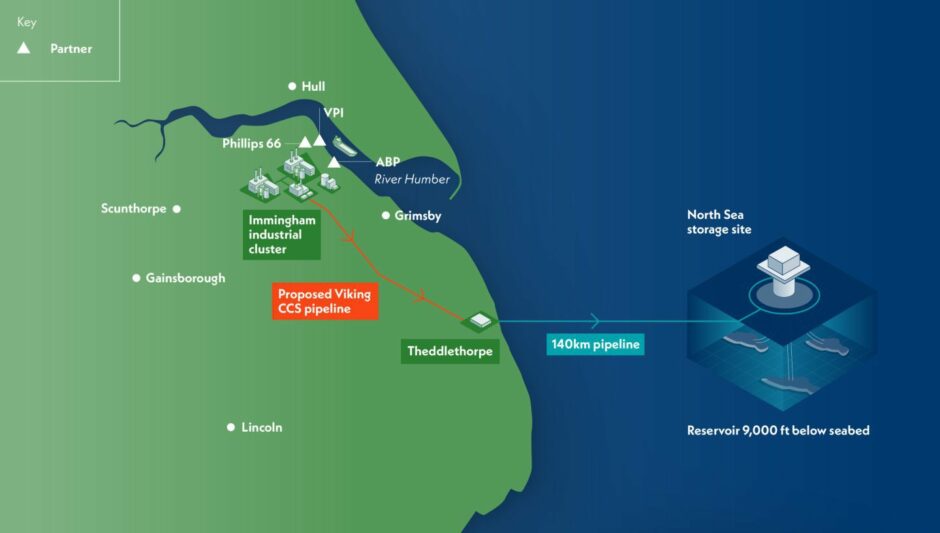
Following the announcement that the Viking CCS project has been awarded two new storage licences, here is everything you need to know about the Humber CCS cluster.
Formerly named V Net Zero, Viking carbon capture storage (CCS) looks to capture emissions from across the south Humber region, the UK’s most industrialised area.
The project is a joint partnership between the UK’s largest producer of oil and gas, Harbour Energy, and BP.
Harbour claims a 60% stake in Viking while the London-listed supermajor holds a 40% share.
The North Sea Transition Authority recently awarded Harbour and BP two new storage licenses for the Humber region project.
The licences are located adjacent and to the west of the existing Viking CCS carbon storage licence in the Southern North Sea.
Harbour says early estimates indicate the additional licences have the potential to increase the total storage capacity of Viking by over 50%.
To this Steve Cox, Harbour Energy’s executive vice president of net zero and CCS, said: “The award of these new licences is another important step forward to help scale up our carbon capture, transportation and storage plans in the UK, and another demonstration of the valuable role the oil and gas sector can bring to the development of this nascent industry.
“The potential for additional storage capacity could play a vital role in supporting the UK to meet its net zero goals while also creating thousands of skilled British jobs.”
Viking CCS Track 2 win
Earlier this year it was announced that Viking was selected for the UK government’s £1 billion Track 2 process.
At the time of this news, Harbour Energy’s chief executive Linda Cook said: “Viking has the potential to be transformational for the Humber, the UK’s most carbon-intensive industrial region, creating thousands of jobs in the area and playing a vital role in supporting the UK to meet its target to capture 30 million tonnes of CO2 annually by 2030.”
It was previously confirmed by geoscience consultant ERCE that Viking is capable of holding up to 300 million tonnes of CO2.
Carbon dioxide will be sent along a newly constructed pipeline from Immingham to Theddlethorpe, before entering the pre-existing 75-mile LOGGS pipeline to reach the depleted Viking gas fields.
Harbour was granted a CO2 appraisal and storage licence for the Viking area in 2021.
Targeting a final investment decision (FID) in 2024, Harbour looks to have the project operational as early as 2027.
Viking CO2 Storage
The previously published schedule for Viking outlined that the project looked to store up to 15 million tonnes by 2035.
There is no indication from the Harbour Energy-BP joint venture on the storage targets per year for the build-up to 2030 as it targets first storage in 2027.
At the time of Viking’s independent evaluation Steve Cox, EVP HSES, Net Zero and CCS, added: “During 2022, we had our contingent CO2 storage resources of 300 million tonnes independently evaluated by ERCE via a Competent Person’s Report, the first project in the UK and we believe only the third in the world to have done so.
“This confirms Viking ’s leading position in the UK’s CCS industry.”
Who’s behind Viking CCS?
In April this year, the energy supermajor BP joined the project obtaining a non-operated share in Viking.
The two firms behind Viking already shared an interest in the Lincolnshire Offshore Gas Gathering System (LOGGS) pipeline, which is earmarked for repurposing as part of the project, when the collaboration was announced.
There are also plans to use a new CO2 shipping terminal at Port of Immingham to bring in emissions from elsewhere in the UK and overseas.
It was reported at the time of the deal that Viking has the potential to unlock up to £7 billion of investment across the full CO2 capture, transport, and storage value chain over the next decade.
During the construction phase of the project, over 10,000 jobs are expected to be created, proving an estimated £4bn of gross value add (GVA) to the Humber and surrounding areas.
Ms Cook previously said: “Viking CCS has the potential to unlock billions of pounds of investment across the full CCS value chain and is crucial for the UK to meet its emissions reduction targets.”
Track 2 win
Alongside the Viking project, Acorn CCS was also a winner of the government’s Track 2 process.
Harbour Energy also has involvement in the project that is set to create a CCS cluster in the north-east of Scotland.
Harbour Energy Said: “We look forward to engaging with the government on both the terms of the economic licence and also the process through which capture projects will be assigned to the Viking CCS cluster.
“Viking CCS can support the decarbonisation of vital industrial and power generation assets across the Humber region and encourage new inward investment across the low-carbon economy.
“With today’s announcement representing a significant step forward for the project, Viking CCS looks forward to continuing to work together with our key capture project cluster members and supporting the wider decarbonisation opportunity in the Humber.”
Prime minister Rishi Sunak said when the Track 2 winners were announced: “This is a good story for the UK overall, it’s not about political seats, it’s just about doing the right thing for the country.
“We’ve got four clusters now across the country that will help us transition to net zero in a new industry, and we’re strengthening our energy security by investing in the North Sea and getting oil and gas rounds there.”
Harbour added: “We are not seeking Government capital grant funding for our Viking CO2 transport and storage project. The award of Track 2 status enables discussions with the government over the terms of the economic licence, ahead of final investment decisions.”
Winners of the previous, Track 1 process, were the East Coast Cluster and HyNet clusters.
In 2021, the UK government split £1 billion between The East Coast Cluster and HyNet as it announced the two projects were the winners of its Track 1 funding round.
Both projects look to cut the country’s carbon emissions by the middle of the decade.
The East Coast Cluster looks to decarbonise industrial emissions around the Humber and Teesside and has the potential to transport and securely store nearly 50% of all UK industrial cluster CO2 emissions.
HyNet is a project backed by Italian operator Eni that aims to remove industrial emissions from north-west England and north Wales.
Opportunity for the UK Supply chain
Earlier this year, A survey carried out by The Crown Estate and Crown Estate Scotland found that the UK carbon capture utilisation and storage sector has ambitions to bring 37 projects online by 2035.
By 2050 respondents to the survey indicated a total of 62 projects to be up and running by 2050.
The two organisations behind the survey explained: “From those developers who responded, their ambition is to bring up to 37 stores online by 2035, with an additional 25 by 2050.”
Of the 22 developers contacted by The Crown Estate and Crown Estate Scotland, 15 answered the questions.
Recommended for you

 © PA
© PA